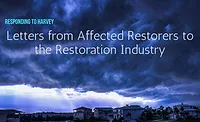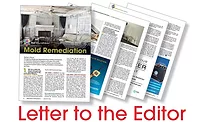Letters to the Editor
Letters from readers regarding the premiere issue of R&R, the cover, the Pittsburgh Protocol and more.
Re: Restoration & Remediation’s Premiere Issue
Dear R&R,
You hit a home run! I’ve had my copy on my desk because I’m reading this issue cover to cover, and other people have walked in here with their own copies to show me this wonderful new publication!
What’s really terrific is that each article is relevant to a restorer. They are written specifically for a restoration company; I cannot envision any one of these articles appearing in other trade publications. That is a wonderful standard to apply: if the article could appear in two or three other publications, it is not sufficiently focused on restoration.
In other words, you have set a clear focus for R&R and have filtered your articles to maintain that focus. That is quite a challenge. Please keep it up as best you can.
Congratulations on a job well done!
Thomas Maguire
Enviro-Care
Buffalo, NY
Dear R&R,
I just received your R&R magazine and found it very interesting and eye appealing. I have been receiving the ICS magazine for some time, and mostly just glanced through the pages, but the new magazine seems to have a lot more flare and more of what I find interesting, restoration. Keep up the good work.
Ted Foster, CR
Signal Building Co.
Troy, Mich.
Re: “The Pittsburgh Protocol” (spring 2007)
Dear R&R,
I was so glad to see Cliff Zlotnik’s article “The Pittsburgh Protocol” in R&R. I have long been a proponent of the wet side cleaning even in fungal situations. Worker exposure is greatly reduced because the wet side cleaning keeps the aerosolized debris down. You can do a better job of cleaning by actually accessing the areas that traditional sanding, wire brushing and other methods just don’t reach. This is one of the things I was fighting for and the reason for getting involved in the first rounds of the [IICRC’s] S520.
After too many years in the field I came to realize that the bacterial component to kitchen and bathroom water losses with fungal contamination could not be ignored. To be honest, I have never “sanded” a job yet. We have never had a call back or problem on any remediation jobs we have ever done…The wet cleaning is by far the best approach for crawlspaces, basements and heavily inundated framed interiors. As long as you monitor the dry-out closely, there are no repercussions.
Glad to see the article. Keep up the good work and getting the word out there.
Jim Mosier
Reiter Mosier Restoration Specialists
El Cajon, Calif.
Dear R&R,
Actually, it should be called the “Salem” Protocol. Where do you think Frank and Mark Headon of First Restoration got it from? We have been doing mold restoration this way for over four years. I have a beer with Mark Headon occasionally and we trade our experience. My background is in petroleum remediation (since 1989), and the principles learned there were simply applied to mold.
IMO, most restoration contractors are lousy mold remediators. One local firm (not First Restoration, they do great work) had to pay over $50,000 to a national builder due to improper response to a black-water discharge. We came in and cleaned up their mess.
I find your magazine excellent and look forward to receiving it.
Harvey Danner, president
Salem Environmental
Charlotte, NC
Dear R&R,
Thanks for sending the premiere issue. I’m just getting ready to open, when I was startled by the picture on the front cover. We consider ourselves leaders in this area (Indiana) of the country and couldn’t believe you chose such a bad photo for your premiere issue.
A lot is going wrong in this photo. I know it might be staged, but make sure the people that are doing it understand what they are doing. If my applicators would apply a detergent/coating this heavy on our projects they would be looking for work at the end of the day. In addition, the applicator looks as if he/she is about to coat a light socket. Where’s your poly/prep protection?
I hope I don’t sound too harsh, but it just seems like they are applying way too much detergent. I’ll get off my soap box (no pun intended) now. Look forward to future issues as the industry welcomes this educational tool.
Good luck!
Michael Honan
DELTA Services, Inc.
Indianapolis, Indiana
The author responds, “A photo without explanation is in both the eye and the imagination of the observer. The photo wasn’t staged; it depicts a stage of onsite small scale test cleaning in an adjacent church building. Having been immersed in floodwater all electrical wiring in the basement was scheduled for subsequent replacement. No electrical hazard from the building existed as we were operating on temporary power. No poly film protection on surfaces was needed as the entire room was considered heavily contaminated. The product applied was a disinfectant cleaner, at ready-to-use concentration. Unlike sprayed liquids which runoff vertical surfaces, the product was being aerated and foamed to enhance surface cling and dwell time. Certainly the Pittsburgh Protocol differs from conventional fungal remediation methods. The severe and unusual demands of the project (presence of fungal, bacterial and chemical contaminates) required deviation from industry guidelines.
Several photos were submitted without accompanying explanation and it was beyond my control which photo the editor used where. The magazine did succeed in getting your attention.” - Cliff Zlotnik
Re: “The Standards of Our Time: Applying IICRC Categories of Water to a Job Situation” (spring 2007)
Dear R&R,
Just thought I would let you know that this has been one of the most important feature articles I have read.
Kerry Holmes
Metro Carpet Care and Restoration Specialists
Queensland, Australia
Re: Restoration & Remediation’s Premiere Issue
Dear R&R,
You hit a home run! I’ve had my copy on my desk because I’m reading this issue cover to cover, and other people have walked in here with their own copies to show me this wonderful new publication!
What’s really terrific is that each article is relevant to a restorer. They are written specifically for a restoration company; I cannot envision any one of these articles appearing in other trade publications. That is a wonderful standard to apply: if the article could appear in two or three other publications, it is not sufficiently focused on restoration.
In other words, you have set a clear focus for R&R and have filtered your articles to maintain that focus. That is quite a challenge. Please keep it up as best you can.
Congratulations on a job well done!
Thomas Maguire
Enviro-Care
Buffalo, NY
Dear R&R,
I just received your R&R magazine and found it very interesting and eye appealing. I have been receiving the ICS magazine for some time, and mostly just glanced through the pages, but the new magazine seems to have a lot more flare and more of what I find interesting, restoration. Keep up the good work.
Ted Foster, CR
Signal Building Co.
Troy, Mich.
Re: “The Pittsburgh Protocol” (spring 2007)
Dear R&R,
I was so glad to see Cliff Zlotnik’s article “The Pittsburgh Protocol” in R&R. I have long been a proponent of the wet side cleaning even in fungal situations. Worker exposure is greatly reduced because the wet side cleaning keeps the aerosolized debris down. You can do a better job of cleaning by actually accessing the areas that traditional sanding, wire brushing and other methods just don’t reach. This is one of the things I was fighting for and the reason for getting involved in the first rounds of the [IICRC’s] S520.
After too many years in the field I came to realize that the bacterial component to kitchen and bathroom water losses with fungal contamination could not be ignored. To be honest, I have never “sanded” a job yet. We have never had a call back or problem on any remediation jobs we have ever done…The wet cleaning is by far the best approach for crawlspaces, basements and heavily inundated framed interiors. As long as you monitor the dry-out closely, there are no repercussions.
Glad to see the article. Keep up the good work and getting the word out there.
Jim Mosier
Reiter Mosier Restoration Specialists
El Cajon, Calif.
Dear R&R,
Actually, it should be called the “Salem” Protocol. Where do you think Frank and Mark Headon of First Restoration got it from? We have been doing mold restoration this way for over four years. I have a beer with Mark Headon occasionally and we trade our experience. My background is in petroleum remediation (since 1989), and the principles learned there were simply applied to mold.
IMO, most restoration contractors are lousy mold remediators. One local firm (not First Restoration, they do great work) had to pay over $50,000 to a national builder due to improper response to a black-water discharge. We came in and cleaned up their mess.
I find your magazine excellent and look forward to receiving it.
Harvey Danner, president
Salem Environmental
Charlotte, NC
Dear R&R,
Thanks for sending the premiere issue. I’m just getting ready to open, when I was startled by the picture on the front cover. We consider ourselves leaders in this area (Indiana) of the country and couldn’t believe you chose such a bad photo for your premiere issue.
A lot is going wrong in this photo. I know it might be staged, but make sure the people that are doing it understand what they are doing. If my applicators would apply a detergent/coating this heavy on our projects they would be looking for work at the end of the day. In addition, the applicator looks as if he/she is about to coat a light socket. Where’s your poly/prep protection?
I hope I don’t sound too harsh, but it just seems like they are applying way too much detergent. I’ll get off my soap box (no pun intended) now. Look forward to future issues as the industry welcomes this educational tool.
Good luck!
Michael Honan
DELTA Services, Inc.
Indianapolis, Indiana
The author responds, “A photo without explanation is in both the eye and the imagination of the observer. The photo wasn’t staged; it depicts a stage of onsite small scale test cleaning in an adjacent church building. Having been immersed in floodwater all electrical wiring in the basement was scheduled for subsequent replacement. No electrical hazard from the building existed as we were operating on temporary power. No poly film protection on surfaces was needed as the entire room was considered heavily contaminated. The product applied was a disinfectant cleaner, at ready-to-use concentration. Unlike sprayed liquids which runoff vertical surfaces, the product was being aerated and foamed to enhance surface cling and dwell time. Certainly the Pittsburgh Protocol differs from conventional fungal remediation methods. The severe and unusual demands of the project (presence of fungal, bacterial and chemical contaminates) required deviation from industry guidelines.
Several photos were submitted without accompanying explanation and it was beyond my control which photo the editor used where. The magazine did succeed in getting your attention.” - Cliff Zlotnik
Re: “The Standards of Our Time: Applying IICRC Categories of Water to a Job Situation” (spring 2007)
Dear R&R,
Just thought I would let you know that this has been one of the most important feature articles I have read.
Kerry Holmes
Metro Carpet Care and Restoration Specialists
Queensland, Australia
Looking for a reprint of this article?
From high-res PDFs to custom plaques, order your copy today!





